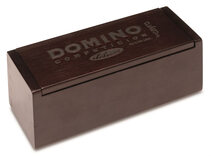Rules of Uckers
Uckers is a more interesting form of Ludo played in the Royal Navy (and apparently some non-British navies). Ludo is a children's game based upon the ancient Indian game of Pachisi. There are other Western versions of Pachisi such as Parchís from Spain, Parcheesi from the USA. Uckers is played by four people with the players opposite each other partnering to form 2 teams. It is essentially Ludo with extended rules that make it a more absorbing and skilful game.
See also: Ludo and Pachisi.
Equipment
Uckers is played on a Ludo board but is played with two dice instead of one.
Basic Play
Players take turns in a clockwise order; the player with the highest throw of the two dice starts. Each throw, the player decides which pieces to move. A piece simply moves in a clockwise direction around the track. There are 2 options:
- One piece is moved the value of one die, a second piece is moved the value of the other die.
- One piece is moved the total value of both dice (the piece does not stop on an intermediate square reached by the throw of one of the die - so cannot take any piece except one lying on the final square).
Starting a Piece
The only way for a player to move a piece from the starting circle onto the track is by throwing a 6. Whenever a 6 is thrown, the player has the option of moving a piece from the starting circle to the first square on the track instead of moving a piece already on the track. A double 6 can be used to start 2 pieces on the track.
Additional throws
A throw of a 6 or a double 6 gives one additional throw of both die. The additional throw happens even if the player cannot move with the 6. The only exception to this is that no additional throws are allowed when a player has just captured a blob (see below). If the additional throw shows a 6 or a double 6, another additional throw is granted, and so on.
Capturing
If a piece lands on an opponent's single piece, the piece jumped upon is returned to its starting circle. If a player's piece lands on a square with one or more of their partner's pieces this is called a 'mixed blob'. If an opponent lands on a mixed blob, all the pieces are captured and returned to their starting circle.
Blobs
If square containing one or more pieces of the same colour forms a barrier known as a 'blob'. By default a blob cannot be passed or landed on by an opponent but a blob does not block a partner's pieces. A blob can be captured but only by following the proper series of events viz.:
- An opposing player must move a piece to the square before the blob.
- The opposing player must next throw a 6 and say "Challenge". Note that a player cannot move into position and say "Challenge" in the same throw. As soon as the challenge has been laid down, the player cannot advance any other piece until the blob is captured or the barrier is returned to a single piece by the opponent. On the challenge turn, the second dice value is forfeited, even if it is a 6. But the player does have an extra throw.
- The opposing player must then throw a 6 for each piece making up the blob. So a blob consisting of 3 pieces needs 4 throws of 6 (including the Challenge throw) to remove it. Unlike the challenge turn, both 6s of a double 6 count towards this end.
- Once the final 6 has been thrown, the capturing piece moves onto the blob's square and the blob's pieces are returned to their starting circle. The turn immediately comes to an end, any unused die value is forfeited and no additional throw is made.
Winning
Once a player has reached the home triangle with all 4 pieces, that player must then throw a six. Once a six has been thrown, from the next turn onwards, that player moves their partners pieces, if possible. When a piece has circumnavigated the board, it proceeds up the home column. A piece can only be moved onto the home triangle by an exact throw. The first team to move all 8 pieces into the home triangle wins.
These rules are provided by Masters Traditional Games, an Internet shop selling quality traditional games, pub games and unusual games. For general information or for copying and copyright, see our Rules Information page.
Our rules are comprehensive instructions for friendly play. If in doubt, always abide by locally-played or house rules.
Copyright James Masters, 2025. All rights reserved.









































